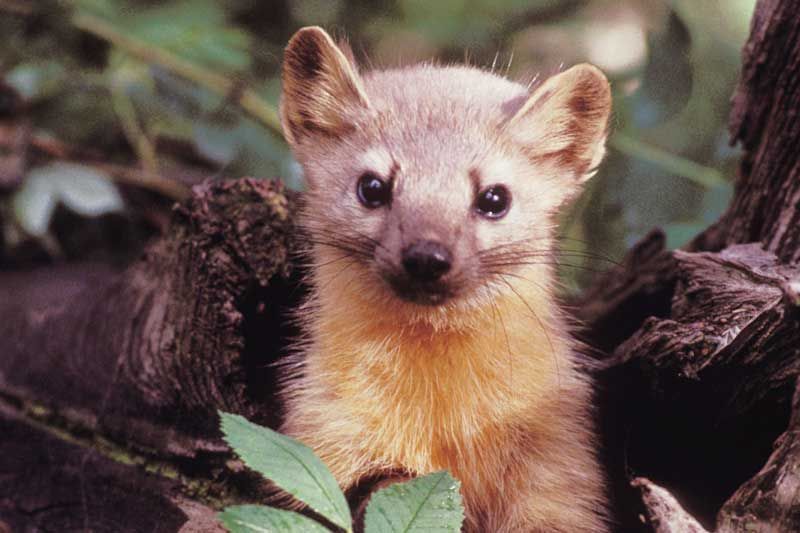Lorraine Julien | Aug 10, 2016
Mink, weasels and martens are all members of the Mustelidae (Weasel family), which also includes otters, skunks, fishers, ferrets, wolverines and badgers. It can sometimes be difficult to make a definite identification with mink, weasels and martens, in particular, especially if you are a distance away and only get a quick glimpse. There are two main differences to look for – size and colouration.
Mink never live far from water - they are a fairly common sight at lakeside homes and cottages, running along the shoreline. In fact, these versatile animals are wide-ranging and can be found anywhere from Florida to the Arctic except in very dry areas. With semi-webbed feet and non-retractable claws, they are great swimmers and tree climbers. Their lustrous fur coat is a solid dark brown colour, although they may have a small pale area on the chin and scattered white spots on the underside.
Mink are fierce fighters that scream, hiss, spit and, like other members of the weasel family (including skunks), emit a pungent odour when provoked. They are larger than weasels, with a body length up to 71 cm long including the tail. With their amphibious lifestyle, mink can feed on a wide variety of prey including fish, crayfish, frogs, garter snakes, mice, moles, water birds and chipmunks. One U.S. study tallied 32 species of prey identified from mink scat and uneaten remains.
Few wild mink are trapped for their fur any more since commercial ranches supply most of the demand for pelts (as many as 100 are needed to make a full length coat).
Weasels, with their long slinky bodies, are smaller than mink but otherwise very similar. Of the three weasels native to Ontario, the Long-tailed Weasel is the largest (30 – 55 cm long including a 10 – 15 cm tail). During the summer months, most weasels have brown fur with white or light coloured fur on the chest and underside. They hunt birds, especially ground-nesters, and can cause considerable damage in a chicken coop. This must be the culprit that used to steal my mom’s hens and chicks.
Weasels can slither through the smallest openings and seem to have rubber bones! Like mink, weasels will eat almost anything that moves and can kill prey much larger than themselves. They do benefit humans, though, by killing rats and mice in fields and barns. Like its cousin, the Ermine, this weasel changes colour twice a year except in the southern portion of its range. Molting occurs over a period of four weeks, and during this gradual process you may see half-white, half-brown individuals. Molts are triggered by changes in the length of days but temperatures may also play a role.
Martens are a shy and very solitary member of the Weasel family and could be mistaken for mink since they are a similar size and colour, except that the Marten tail is bushy and almost black compared to the rest of the body, which is dark brown. They are mainly nocturnal but occasionally can be seen during the day chasing a squirrel. I had a quick glimpse of this elusive creature one day as my canoe glided silently near the shore and I was able to catch it by surprise. Among the Mustelids, martens are much more carnivorous than skunks and less so than weasels. They love to eat birds’ eggs (like many of their cousins), insects and, when in season, blueberries. In fact, they’ve been known to eat so many blueberries that their lips are noticeably blue!
Predators of these animals include coyotes, bobcats, large owls and human trappers. Since weasels are lightning quick, they must be difficult to catch unless slowed by old age or sickness.
We recently had an inquiry, along with beautiful photos, from one of our readers inquiring as to the identity of an animal that was either a mink or a weasel. An exact identification was difficult since the photos did not show a complete body and all of these animals are similar and love to be near water.
Please send your observations to Lorraine Julien at This email address is being protected from spambots. You need JavaScript enabled to view it. or Steve Blight at This email address is being protected from spambots. You need JavaScript enabled to view it.
More Stories
- Annual Fool's Plunge
- Swimmers Raise Funds & Goose Bumps for Good Causes
- Election 2025 Candidate Scott Reid
- North Buxton: A Journey of Freedom and Unity
- Sarah Gillingwater: A New Generation at the Review Mirror
- New Kid on the Realty Block
- Does Michelle Foxton Have A Chance to Beat Scott Reid?
- Mayor Wants To Raise The Flag High In North Frontenac
- North Frontenac Little Theatre and Joseph & the Amazing Technicolor Dreamcoat
- Central Frontenac Asked to Show Canadian Pride

